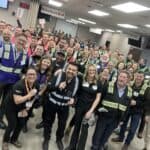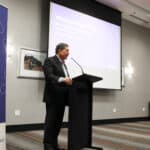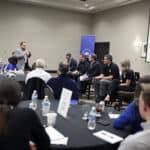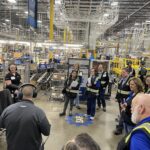Exploring Digital and Physical Convergence at Eclipse Automation
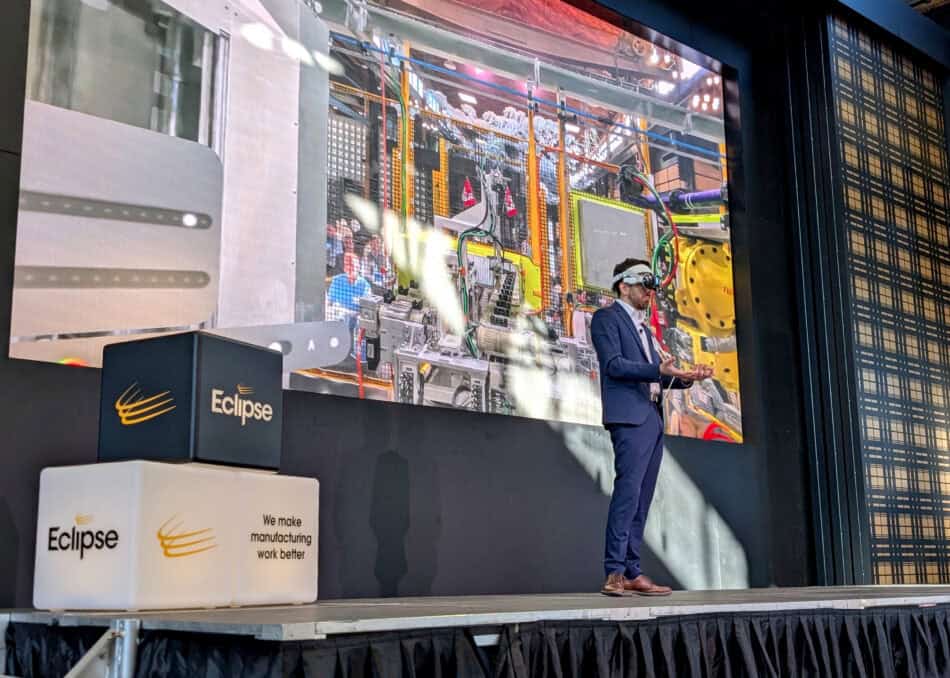
From immersive tech demos to shop-floor innovation, MLC members got an exclusive look at how Eclipse Automation is turning digital transformation into real-world results.
Eclipse Automation opened the doors to its Cambridge, ON facility for MLC members and guests, showcasing the latest innovations in factory automation, digital twins and the omniverse.
The event included a tour of the 200,000 square foot facility, presentations, a panel discussion and opportunities for manufacturers leaders to network and discuss digital and physical convergence and the factory of the future.
Eclipse delivers advanced systems that help manufacturers accelerate production, improve quality and strengthen resilience across industries—from life sciences and transportation to consumer products and electronics. The company’s Cambridge facility serves as both a hub of engineering innovation and a showcase for its latest advancements in smart automation.
Innovation in Action at Eclipse
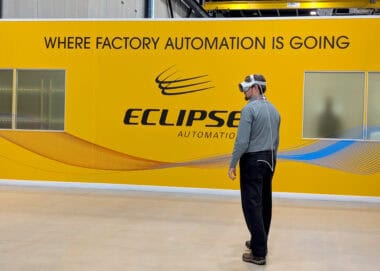
The day began with a welcome from Cambridge Mayor Jan Liggett and an opening keynote by the MLC’s Steven Moskowitz, Ph.D., setting the stage for a day dedicated to digital and physical convergence. Eclipse Automation’s newly appointed president, Michael Fisher, delivered a corporate overview “assembling physical and digital momentum.” Attendees were then immersed in a hands-on Omniverse demonstration, offering a glimpse into the collaborative power of augmented and virtual reality. Using an Apple Vision Pro attached to a projector, participants saw how digital twins and real-time modeling can streamline design decisions and accelerate project timelines.
Inside iPort
The highlight of the morning was the guided tour of Eclipse’s iPort facility, where attendees visited three immersive stops.
- At the Gaussian Splatting Galleria, guests stepped into a virtual workspace that erased physical barriers, revealing new ways to collaborate and problem-solve in real time.
- The Factory Automation Galleria offered a behind-the-scenes look at Eclipse’s innovation process—where ideas move rapidly from concept to prototype to production and projects are derisked.
- Finally, at the Eclipse Experience in Motion stop, visitors walked the active shop floor to observe how Eclipse’s multidisciplinary teams bring complex systems to life.
The tour concluded with a stop at the Technology Galleria, where technology partners demonstrated the tools and platforms shaping where factory automation is going.
Where Digital Meets Physical
In the afternoon, attendees participated in thought leadership presentations and discussions. Breakout sessions covering Smart Manufacturing Playbooks and Generative AI at the Edge were followed by a panel discussion where tour participants were able to ask questions about digital transformation, automation and workforce innovation to a panel of experts.
The tour offered a rare glimpse of the technologies and strategies that are redefining the future of the factory.
Photos and video by Ryan Dentinger, Eclipse Automation
Digital Manufacturing in Action at GM’s Cadillac Plant in Tennessee
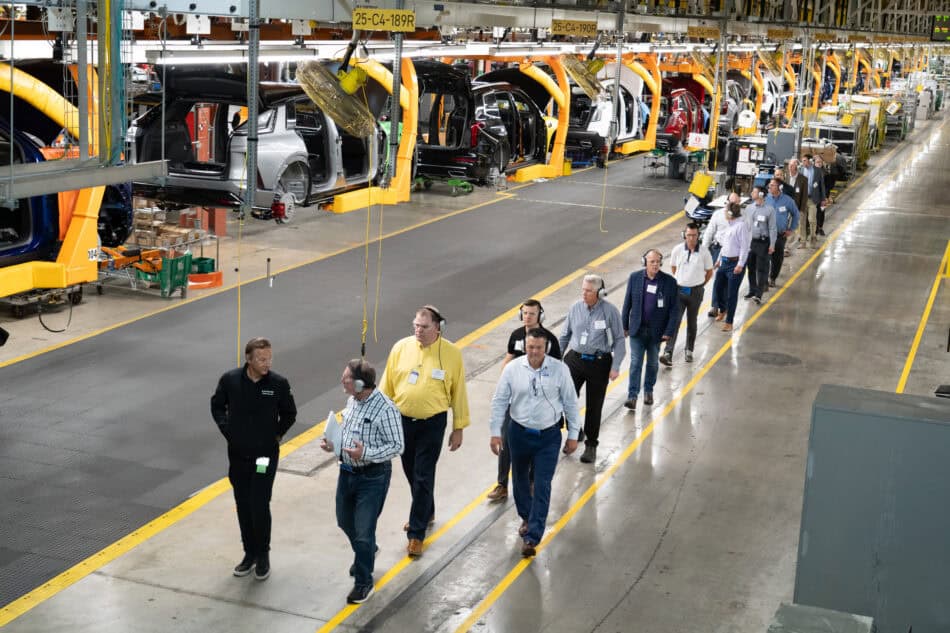
Robotics, AI and people work together to shape the future.
Henry M. Leland, who founded Cadillac in 1902, believed in creating superior products. Cadillac’s early slogan, “The Standard of the World”, reflected his philosophy of establishing a mark of excellence in the automotive industry.
Over the years, Cadillac delivered on that philosophy with innovations that included the pioneering development of interchangeable parts, the first fully enclosed automobile cabin and first electric starter, the first mass produced V8 engine, fuel injection, and many other accomplishments.
The famous Cadillac Crest symbolized Leland’s philosophy. Featuring mythical birds called merlettes, which are derived from the family crest of Antoine de la Mothe Cadillac, the founder of Detroit whom Leland named his automobile after, the crest symbolized a constant striving for excellence. The crest has undergone more than 30 redesigns and even though the merlettes are no longer used in the logo—they do appear as an “Easter Egg” on the LYRIQ’s dashboard—the message of excellence remains.
Today, Cadillac, which General Motors acquired in 1909, remains the premier brand of its $187 billion parent, and is leading GM’s charge in the electric vehicle market. In early September, nearly 100 members of the Manufacturing Leadership Council toured GM’s 11 million-square-foot, 4,000-employee Spring Hill, TN, Cadillac factory to see how Cadillac’s electric LYRIQ and VISTIQ and internal combustion engine-based XT5 and XT6 vehicles are manufactured. The factory will begin building the Chevy Blazer in 2027.
On the Factory Floor
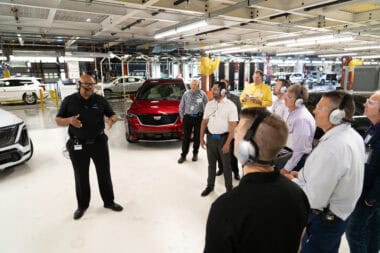 What MLC members saw was a highly automated and digitalized factory that uses robotics and artificial intelligence to improve safety, quality, and efficiency on the manufacturing floor.
What MLC members saw was a highly automated and digitalized factory that uses robotics and artificial intelligence to improve safety, quality, and efficiency on the manufacturing floor.
As one example, GM has a joint venture with LG Energy Solutions to make Ultium cell batteries in Spring Hill.
The batteries are inspected in error proofing stations using cameras and laser stations that check connections. AI is used to detect problems. Together with GM’s Avantguard system, which tracks work sequences and steps, these stations have resulted in a significant drop in warranty issues for customers.
In the assembly operation, MLC members witnessed a GM first—a robot installing a seat in a car on a moving conveyor without human involvement. The operation relies on a vision system and Light Detection and Ranging (LiDAR), a remote sensing method that uses pulses of laser light to measure distances and create 3D models, to align the seat and place it in the precise location while also maneuvering through the door holes.
MLC members also saw how GM mixes vehicle types on the same production line. All five vehicle types produced in the factory, including both EV and internal combustion engine vehicles, are assembled on the same line. Automated mobile robots deliver the proper chassis to each vehicle body as the unfinished cars move down the line. With five different models moving down the line at the same time, the company has paired automation and AI with a surprisingly simple way for workers to identify each vehicle model. A color-coded temporary overlay on the vehicle’s fender signals which vehicle they’ll be working on next.
Beyond the Factory Floor
Breakout session topics included supply chain management and manufacturing optimization. In the supply chain session, tour participants learned that the company’s focus is on simplifying and streamlining supply chain operations so that it can achieve more flexible operations. To improve efficiency, their guiding principle is to fit one more part in every box and move that box one less foot.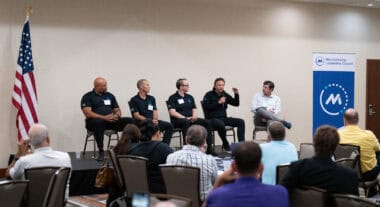
In the optimization session, GM shared that the company’s automation rationale is based on three factors: safety, continuous quality improvement, and efficiency.
According to GM, the best manufacturers know how to get the most out of their technology, equipment, and people—noting that each brings something valuable to the table. The key now is to select the projects that deliver the most ROI while staying true to Cadillac founder Henry Leland’s quest to be the standard of the world.
Photos by David Bohrer/National Assoc. of Manufacturers
MLC Plant Tour: United Scrap Metal and Its Vision for a Coast-to-Coast Recycling Network
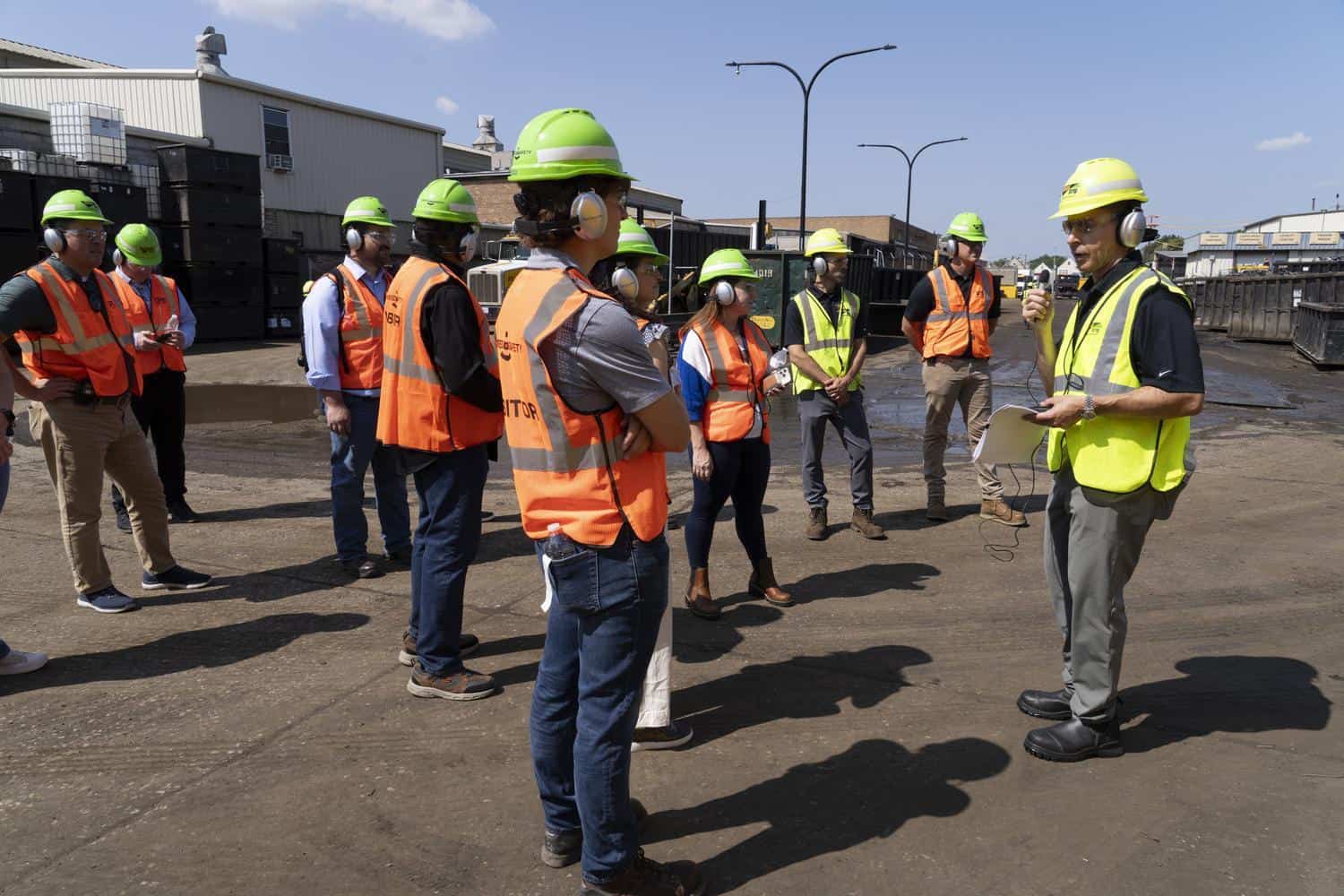
Photos by David Bohrer/National Assoc. of Manufacturers
While every new business starts with big dreams, only a few rise up to those lofty early expectations, and even fewer exceed them. While United Scrap Metal founder Marsha Serlin certainly had a vision for her company’s future, it’s hard to believe she knew the impact her fledgling business would have when she started it in 1978 with $200 and a rental truck.
While the company headquarters still sits at the same Cicero, IL, location where it first began, several expansions over the years have built it up to a 50-acre site. The company now has 10 additional locations in its portfolio and is spread over nine states, bringing in annual revenue of $725 million. MLC members took part in a tour at USM’s headquarters location on August 13, learning about these accomplishments and ambitions, as well as the operations and technology behind industrial recycling.
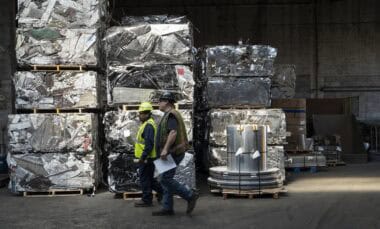
USM’s business is recycling scrap metal from both residential and commercial customers, producing material commodities for mills, foundries, casting and specialty markets. This includes ferrous and non-ferrous materials and some non-metallic materials such as paper, plastic and wood.
Risk management is imperative for any recycling business and USM puts a high emphasis on materials integrity, taking care not to accept anything that could harm their employees or customers. This includes not just dangerous substances, such as refrigerant left behind in air conditioning units, but also ensuring that materials don’t have dubious origins – catalytic convertors are not accepted, for example, due to their frequent theft. Materials are integrated into a digital tracking system at intake. The company utilizes a real-time inventory management platform that tracks location, process status, and so on for materials as they move through processing.
Like many manufacturers, USM is beginning to integrate AI into its operations, with some current use cases in customer service, fleet management and predictive maintenance. The company is making inroads on AI-driven data analysis to make informed decisions and uncover some of the “hidden links” that might lie within production data.
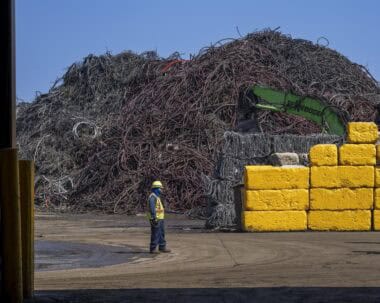
Beyond its operations, USM also emphasizes its culture and community service. The company places a high priority on continuous improvement and teamwork at every level of the organization. They are transparent on their goals to give team members an incentive to perform. While the company has grown by acquisition, they have only brought in organizations that were the right cultural fit.
This extends to outside of the organization as well; the company has turned away customers that don’t fit if it could result in a poor customer experience later on – for example, a company with materials that USM might not be able to process and sell. In these cases, USM says they have helped those potential customers find the appropriate vendors and businesses to fit their needs.
Philanthropy is also a significant part of USM’s culture, with the company holding long-standing relationships with Ronald McDonald House Charities, Special Olympics, United Way, American Red Cross, Habitat for Humanity and others.
As the company approaches its 50th year, they continue with that same ambitious and plucky spirit that fueled its origins. They are expanding into a recently built warehouse at their headquarters location and seeking potential acquisitions for their ever-growing location portfolio. They look to build a coast-to-coast network and to capture new market share, all while providing excellent customer alignment and investing in new process innovations.
Most of all, they seek to hire and retain the best and brightest and to live by the values that have served them—and acted as a catalyst for success—for nearly five decades.
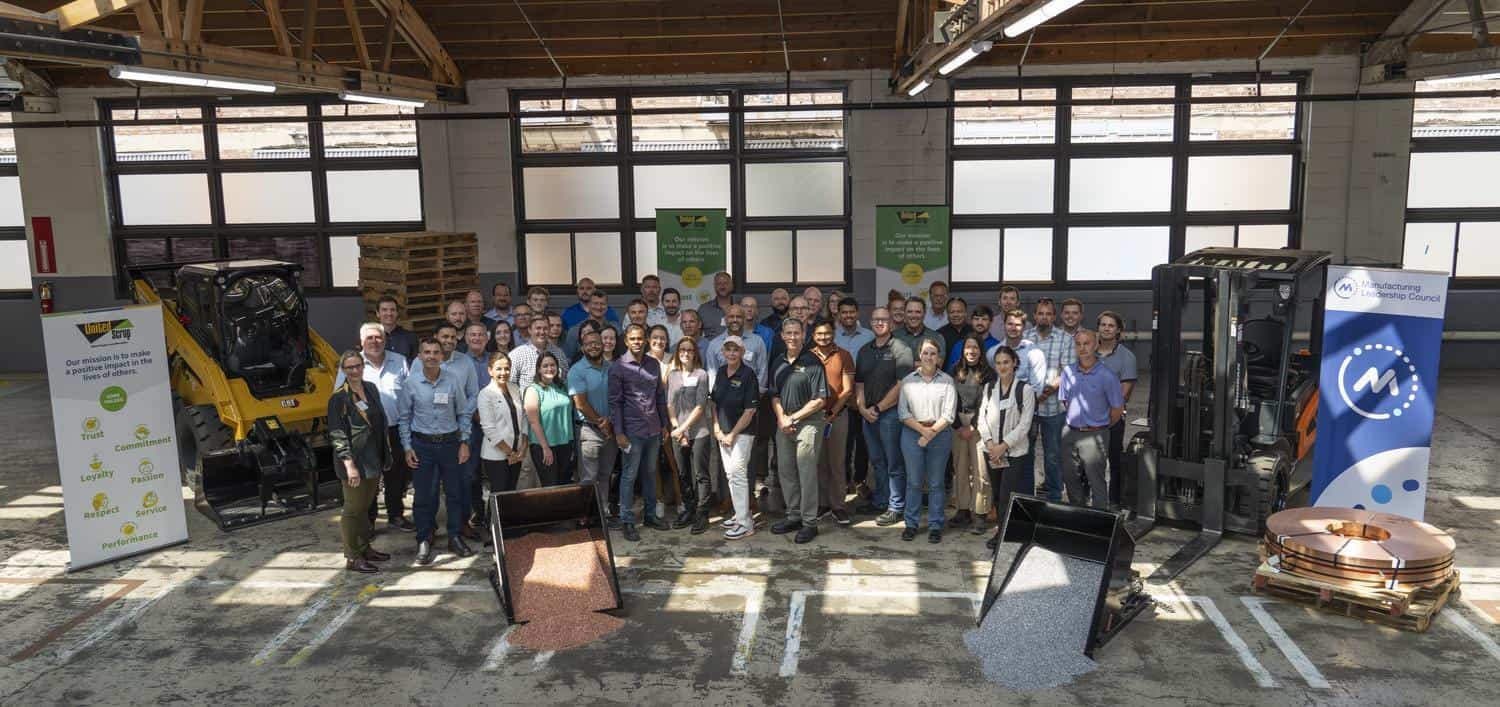
In Mexico, Schneider Electric Showcases “Lighthouse” Accomplishments
 Founded in 1836 when two brothers, Adolphe and Joseph-Eugene Schneider, took over the Le Creusot foundry in Burgundy, France, Schneider Electric today is a €38 billion energy management and automation provider with 150,000 employees doing business in more than 100 countries.
Founded in 1836 when two brothers, Adolphe and Joseph-Eugene Schneider, took over the Le Creusot foundry in Burgundy, France, Schneider Electric today is a €38 billion energy management and automation provider with 150,000 employees doing business in more than 100 countries.
The company manufactures its broad array of electrical and automation products at 200 factories around the globe, seven of which have achieved the distinction of being awarded World Economic Forum Lighthouse status. The WEF Lighthouse program measures adoption of advanced 4IR technologies, the financial and operational accomplishments, and its set of transformation enablers. There are 189 Lighthouses worldwide.
Approximately 100 Manufacturing Leadership Council members and guests toured one of Schneider Electric’s Lighthouse facilities earlier this month in Monterrey, Mexico. Known as Monterrey Plant 1, the seven-year-old, 450,000-square foot facility makes, warehouses, and distributes electrical products such as circuit breakers, panel boards, and numerous electrical distribution products.
The Monterrey factory’s digital management backbone is Schneider’s EcoStruxure platform, described by the company as an open, Internet-of-Things-based system that combines embedded connectivity, intelligence, and standard communication protocols to generate operational data, analyze that data, and make control decisions.
The EcoStruxure system has enabled the Monterrey plant to reduce downtime by 25% while achieving a 29% reduction in energy consumption. Schneider Electric says the Monterrey factory is the first factory in Mexico to achieve zero waste to landfill. The factory’s sustainability effort is part of Schneider Electric’s corporate goal to achieve Net Zero by 2050.
The tour for MLC members consisted of 10 stops on the factory floor. At each stop, Schneider Electric team members explained how they work, the systems they use, and how their particular work area fits into the factory’s overall flow. Among these stops, visitors witnessed data center resiliency, the company’s Lean Digitization System, deep learning vision for quality, IoT and machine learning for metal finishing operation uptime, and standardized MES for panel board assembly operations. Advanced MPH was also on display with the use of drone technology for warehouse cycle count and AGV utilization.
After the tour, a panel discussion with plant management, moderated by MLC, was held to allow MLC members to ask questions about what they had seen on the plant floor. Breakout sessions on brownfield plants, the Schneider supply chain, and the WEF’s Lighthouse program were also held during the day.
The MLC’s next plant tour will take place at United Scrap Metal on August 12-13, 2025 in Cicero, Illinois. Register for this tour and learn more about all of MLC’s plant tours: https://manufacturingleadershipcouncil.com/event/plant-tours.
About the Authors:
David R. Brousell is founder, vice president and executive director of the Manufacturing Leadership Council
Steven Moskowitz, Ph.D., is the senior director, event content at the Manufacturing Leadership Council.
EnerSys Tour Offers Immersive Lean Manufacturing Insights
MLC members explore lean ecosystems, advanced battery production, and agile fulfillment strategies at EnerSys' Richmond facility.
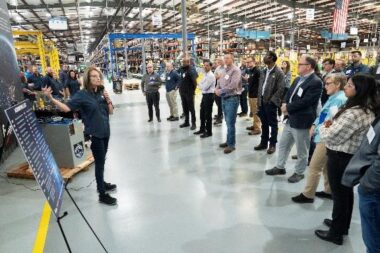
EnerSys’ Richmond, Kentucky, facility opened its doors to Manufacturing Leadership Council members, offering a first-hand look at how a century-old operation has evolved into a benchmark for modern lean manufacturing, assembly and distribution. The visit was more than a tour—it was an immersive experience into lean principles that are not just deployed but embedded holistically across processes, people, and locations. The EnerSys Operating System and the integration of traditional and advanced battery production demonstrated the power of scalable lean ecosystems that operate seamlessly in both legacy and digitally transformed environments.
The Richmond site produces battery chargers and batteries, some weighing as much as two tons. The batteries produced in Richmond include traditional lead-acid motive power batteries for industrial equipment, maintenance-free thin plate pure lead (TPPL) batteries, and lithium-ion batteries. Tour participants made their way through the company’s Mega Distribution Center and the battery manufacturing facility.
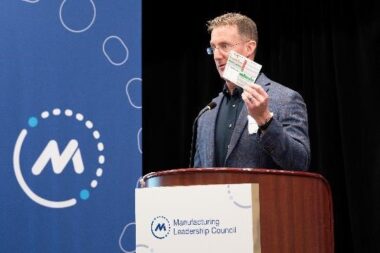
One highlight of the tour was EnerSys’ innovative 24-hour “book-and-ship” program, demonstrating how lean principles have enabled fast and flexible responses to customer needs. Visitors also observed how EnerSys identifies and eliminates waste to improve efficiency and enhance sustainability. This included a deep dive into how employee-led initiatives, coupled with digital tools, have driven continuous improvements in product quality, workplace safety and other areas.
These employee-led initiatives play a critical role in driving continuous improvements in quality, safety, and operational performance. Tour attendees were also invited to engage directly with these processes by completing Accountability Tag cards—an exercise EnerSys employees regularly use to spot and address operational deficiencies. The cards prompted participants to document potential problems, propose quick fixes, and complete a 5 Whys analysis to uncover root causes.
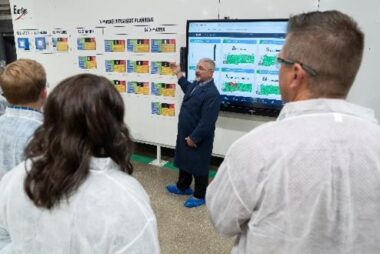
The tour concluded with two breakout sessions and a panel discussion and Q&A session where EnerSys leaders answered participants’ questions. The company’s leaders focused on the challenges of scaling the EnerSys Operating System, the role of technology in their processes, and what’s next for the company.
Participants left the event with actionable insights to apply within their own organizations. Many were inspired by EnerSys’ ability to seamlessly blend traditional manufacturing with modern technology, proving that even legacy operations can achieve agility and innovation.
All photos by Ian Wagreich / National Assoc. of Manufacturers, Copyright 2024
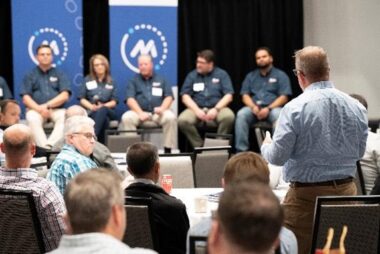
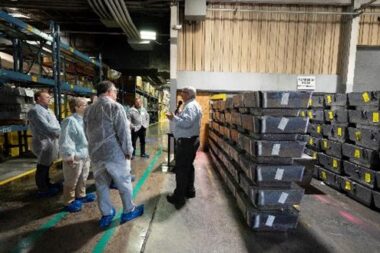
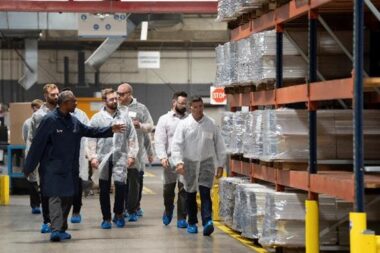

Exploring Automation and Culture at Amazon
From garage to global giant: how innovation, data and machine learning drive Amazon’s BFI4 Fulfillment Center

Nearly 30 years ago, in a Seattle-area garage, Jeff Bezos and the few employees of his upstart online retailer, Amazon, knelt on the floor to pack customer orders into boxes. One evening, Bezos suggested ordering kneepads to make the work more comfortable. One of his workers respectfully disagreed and suggested they order packing tables instead – an option that proved to be better for worker satisfaction and throughput. This early example of centering durable needs, rather than immediate or short-term needs, exemplifies the culture of innovation that now permeates Amazon.
During MLC’s sold-out tour of Amazon’s BFI4 Fulfillment Center cohosted by Amazon Business and Amazon Web Services, participants got a behind-the-scenes look at how the company sorts and packages thousands of items per day for delivery to customers. The tour also provided insights into Amazon’s approach to data, supply chain and procurement, offering a deep dive into the progression of the company’s culture from its early days.
During his presentation on the culture of innovation, Clint Schneider, Amazon Web Services’ Digital Innovation Lead for Smart Factories, shared how culture, mechanisms, architecture and organization lead to better innovation. Schneider explained how Amazon’s decision-making process uses the concept of “one-way” or “two-way” doors to make high-quality, high-velocity decisions. A one-way door represents a significant decision like should Amazon build a new facility, while a two-way door represents something less critical, like changing the buy button’s color.
Using the one-way versus two-way door analysis helps the company innovate faster with a bias for action. If it is a two-way door, they know they do not have to deliberate as long. Instead, they can run the experiment and move back through the door to adjust or revert if the decision does not produce the intended results and ROI.
Automation and Innovation at Amazon’s BFI4 Fulfillment Center
“This is what we manufacture,” Julius Yu, General Manager of Amazon’s BFI4 Fulfillment Center shares as he holds one of the thousands of packed boxes filled with a customer’s order that move by the MLC tour group as they walk through the facility. “Everything we manufacture here is unique.”
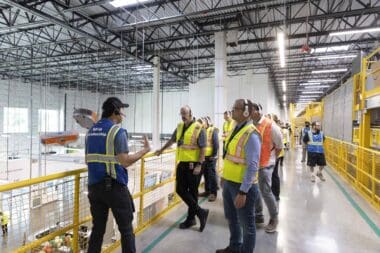
BFI4 handles millions of units per week, each with a distinct mix of “parts” that are sorted, picked, packed, inspected, sealed, labeled and distributed for delivery. BFI4 is Amazon’s eighth iteration of an Amazon robotics fulfillment center. In total, BFI4 has thousands of mobile robots storing and transporting products between stations where they are manually sorted for storage then picked and packed for delivery.
At the sort station, employees put items into random bins for storage until a customer orders the product. Using a vision system, a camera takes a picture of where the item has been randomly placed so that it can be retrieved and transported via AMR to the pick station when ordered.
After the product is ordered and delivered to the pick station, a control panel tells employees where it is located on the rack so they can move it into a bin to be packed into a customer’s box. Computer vision verifies the number of items in each bin, taking pictures to ensure accuracy.
Harnessing Data to Improve Efficiency
Data, data management, and data contextualization are integral to operations at BFI4. The company generates terabytes of data to ensure end-to-end transparency. Machine learning helps determine which fulfillment center or distribution center across the country should house each product, using historical ordering patterns with about 60% accuracy. These determinations help to improve delivery speeds, and have resulted in more efficient delivery routes. While machine learning hasn’t helped Amazon achieve 100% accuracy yet, Yu is optimistic that advancements in technology, computing power and artificial intelligence will improve precision.
One notable innovation using data is a custom box maker. For orders that include a single item, Amazon’s machine will custom cut cardboard to create a shipping box. The custom box maker relies on product data to determine the correct size of the box so that it can fit snug around the product. The downstream benefits are significant. The company can fit more boxes into trucks, for example, which is a positive for both sustainability and throughput.
An Immersive Amazon Experience
Participants enjoyed a networking reception the evening prior to the tour featuring entertainment by Washington-based 2019 American Idol contestant Kazmyn, food options from local vendors, and a trip to Amazon’s iconic Banana Stand – all hosted in Amazon’s Spheres, an innovative coworking space. The reception gave participants an opportunity to network with fellow tour participants and Amazon ambassadors while immersed in a unique Amazon workspace ecosystem.

Following the tour, attendees engaged with a panel of Amazon experts including Julius Yu, Brian Steward (Director of Worldwide Amazon Business Operations), and Mobeen Khan (Director, Global Business Development and Partnerships), facilitated by MLC’s Senior Content Director, Penelope Brown. The panelists addressed questions about the BFI4 facility, data, culture, safety and Amazon’s processes.
The Amazon tour experience concluded with a session titled “Manufacturing at Amazon: The Future, Faster, Together,” covering three pillars for manufacturing’s future: data as a foundation, AWS supply chain, and strategic procurement.
For participants, the tour proved to be a fascinating opportunity to see how far Amazon has come since those earliest days when employees packed customer orders in a garage and where the company’s culture of innovation may lead it in the future.
A Pioneer in Automation Becomes a Champion for Digital Transformation
Rockwell Automation’s history points to a pioneering drive to make machines smarter. From its 1903 founding as the Compression Rheostat Company, soon to be renamed the Allen-Bradley Company, the company started with an early prototype machine controller and 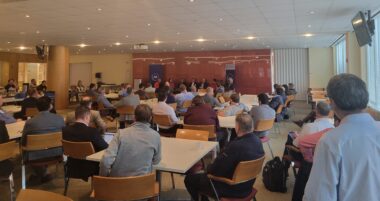 is now a world leader in digital transformation – both for its own operations and in offering guidance for its customers. Today, Rockwell is a $9 billion company with nearly 29,000 employees serving customers in 100 countries.
is now a world leader in digital transformation – both for its own operations and in offering guidance for its customers. Today, Rockwell is a $9 billion company with nearly 29,000 employees serving customers in 100 countries.
In early April, a group of Manufacturing Leadership Council members toured Rockwell’s electronic assembly plant in Twinsburg, Ohio, just outside of Cleveland. The theme of the tour was “Build a Digital Transformation Culture with MES and IoT Technology.” The 250,000-square-foot Twinsburg plant is one of four main electronic assembly locations within Rockwell that provide printed circuit board assemblies that go into the company’s products, with Twinsburg’s eight surface mount technology lines placing three million components and forming 11 million solder joints to make 3,000 control panels each day.
Rockwell’s manufacturing operations is regarded by many as a role model for system integration and data analytics. The company monitors and integrates its engineering data, material management data, product error proofing and genealogy, machine data, quality data, waste data, and performance data. Data is delivered to where it is most relevant and impactful, from facility performance to team leaders down to the specific work order and line performance for operators.
The company utilizes its FactoryTalk production system, industrial automation software that was developed to streamline processes while improving precision and reducing errors. It creates an interactive platform that can integrate data visualization, data collection and analysis, process design, and system diagnostics. Rockwell offers a full suite of FactoryTalk products, including for analytics and data management, product and process design, human-machine interface, industrial communications, maintenance, performance monitoring, and more.
Additionally, Rockwell utilizes a closed loop operating system that combines scheduling and constraint management, and automatically enforces finite capacity based on, for example, the number of operators available at the plant on a given day. Company leaders say this system has helped to eliminate some of its functional siloes, as its development was collaborative and cross-functional, with many different teams giving input to create a tool that could benefit all. While FactoryTalk is already available for manufacturers to license at their own facilities, Rockwell has an eye toward commercializing its closed loop operating system as well.
The tour didn’t shy away from showing both Rockwell’s tried-and-true technologies in addition to its newer ones, including a robot for final testing and assembly that utilizes a digital twin and AR to train operators and maintenance technicians. The machine is being used to create robot standards that can be scaled elsewhere throughout its other manufacturing facilities. At the time of the tour, it had been on the factory floor for less than eight weeks.
When Rockwell’s operations leaders were asked the top reasons for starting their digital transformation journey, they mentioned a need to address a huge uptick in demand, high turnover in the workforce that has led to far less tribal knowledge among frontline operators, and a desire to improve constraint management – both identifying and resolving those constraints. Looking toward the future, the company wants to capitalize on the momentum it has established on its digital transformation journey, explore the opportunities presented by AI and generative AI, and operate on the basis of real-time data-driven decisions.
Rockwell’s leaders also pointed to culture as key to getting functions and teams to work together while moving forward on technology transformation. When it comes to dealing with the complexity created by working with multiple layers of software, they think of it the same way as they do when developing their own products – take things that are sophisticated and make them easy to use by designing them for an operational environment.
Never one to shy from innovation, Rockwell is looking to an exciting future of possibilities ranging from developing large language learning models for manufacturing to building industrial ecosystems to creating a comprehensive data loop that moves between customers, engineering, and manufacturing. It seems fitting for a company that has placed itself as a cutting-edge leader from the radio age to the space age to the data age.
Read a full interview with Rockwell CEO Blake Moret here.
Dotson Iron Castings’ Story of Survival and Advancement
When a company traces its history back nearly 150 years, its story is likely one of continuous change and evolution. For Dotson Iron Castings of Mankato, Minn., it is also a story of survival, innovation and respect for people.
During the Manufacturing Leadership Council’s recent plant tour, Dotson’s leaders shared elements of this story and gave visitors a firsthand look at its production practices and culture.
Overcoming Obstacles
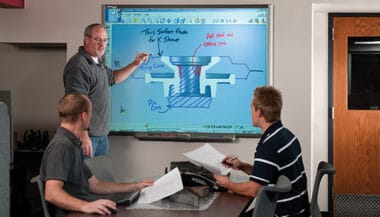 With its roots dating back to a blacksmith shop founded in 1876, Dotson Iron Castings has persevered through early product failures, a 1937 bankruptcy, the 1980s recession, a 2017 fire, and the COVID-19 pandemic, and emerged stronger due in part to the company’s leadership, people and culture.
With its roots dating back to a blacksmith shop founded in 1876, Dotson Iron Castings has persevered through early product failures, a 1937 bankruptcy, the 1980s recession, a 2017 fire, and the COVID-19 pandemic, and emerged stronger due in part to the company’s leadership, people and culture.
In its early history, the company offered diversified products including an automobile, a tractor and its best-seller, the Little Giant Trip Hammer. The company also dealt in brass, aluminum, and steel. Since 1983, the 125,000 square foot foundry has focused solely on ductile iron primarily for the industrial, agriculture, and truck industry segments. By focusing on this single product, Dotson has become an iron casting and Manufacturing 4.0 leader.
Innovating for the Future
As the company has evolved, its leadership and employees have created a culture that respects people and encourages innovation. The company’s Manufacturing 4.0 journey has seen Dotson implement data generation and collection systems including a FARO Quantum Scan Arm that takes 3D measurements to inspect product quality. Other innovations showcased during the MLC tour include machine monitoring data, automated charging in the melt process and automatic mold pouring.
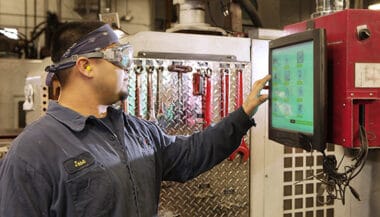
On the sustainability front, the company continues to find new ways to reuse energy and materials. It takes a tremendous amount of energy to reach iron’s 2700 degrees Fahrenheit (1482° C) melting point, which in turn creates heat energy that Dotson captures and uses to heat its facility in winter months, including an in-ground heating system to keep its loading dock area free from ice and snow – both common for Minnesota. The company reuses excess iron that is removed from castings in the finishing process and also reclaims the sand used in its molds, eliminating almost 70% of the non-recyclable waste leaving its facility.
Recognizing an Iron-Willed Team
 When an electrical contractor caused a fire that destroyed all the company’s molding lines in 2017, it took Dotson six weeks to rebuild its operation. Rather than send workers home, company leaders kept its frontline workers employed in the cleanup process or by sending them out into Mankato to complete community service work.
When an electrical contractor caused a fire that destroyed all the company’s molding lines in 2017, it took Dotson six weeks to rebuild its operation. Rather than send workers home, company leaders kept its frontline workers employed in the cleanup process or by sending them out into Mankato to complete community service work.
After rebuilding and reopening the foundry, the company’s then-owners, Denny Dotson and Jean Bye, envisioned and built a new worker-focused space with showers, changing areas, lockers, upgraded break areas including an outdoor terrace, and a more welcoming reception area. The company calls this new space the “Club House,” and it serves as a further indication of the company’s commitment to its people.
More than Just a Tour
For MLC’s plant tour participants, the visit to Dotson Iron Castings included more than just a tour of the foundry and Club House. Visitors had the opportunity to network with fellow Manufacturing 4.0 professionals, participate in one of three breakout sessions, and ask questions both during the tour and a capstone panel discussion.
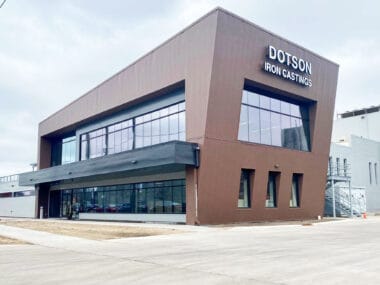 The breakout sessions dove deep into key topics facing both Dotson and participants alike: IT/OT Convergence, Energy Efficiency in an Energy Intensive Industry, and The Employee Center and Next Generation Workforce Influence. Dotson’s leadership team shared its experiences and answered questions, shedding light on the company’s continuing evolution.
The breakout sessions dove deep into key topics facing both Dotson and participants alike: IT/OT Convergence, Energy Efficiency in an Energy Intensive Industry, and The Employee Center and Next Generation Workforce Influence. Dotson’s leadership team shared its experiences and answered questions, shedding light on the company’s continuing evolution.
The event culminated with a wide-ranging panel discussion featuring nine representatives of the host company. The panelists fielded audience questions about workforce turnover, technology innovation, and how the company has perpetually overcome challenges.
The Dotson Iron Castings tour showcased how the company – forged in fire – has equipped its employees with the right technologies and created a culture that is poised to build on its 147-year history.
All photos courtesy Dotson Iron Castings
At Hershey, a Sweet History and Saltier Future Powered by Digital
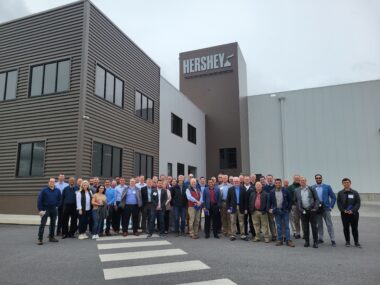
From its namesake chocolate bars to the immensely popular Reese’s Cups, The Hershey Company has been a maker of beloved confections for many decades. But no matter which variety is your personal favorite, Hershey’s powerhouse combination of manufacturing, fulfillment and distribution keeps those famous brands coming to store shelves and to the consumers who love them, generation after generation.
Nearly 100 Manufacturing Leadership Council members took part in a tour encompassing two Hershey facilities: the West Hershey plant in Hershey, Pa., and their nearby Annville Fulfillment Center in Annville, Pa., which is also Hershey’s first fully digital facility.
As a $10 billion publicly traded company, Hershey is perhaps most famous for its chocolate brands and other confections, but it also has expansion goals to evolve into a leading snacking powerhouse. To that end, it has acquired several brands of salty snacks, including Skinny Pop Popcorn, Pirate’s Booty puffs and straws, and Dot’s Pretzels. Its nearly 4,000 SKU brand portfolio is carried out through 21 plants (14 in the United States, seven internationally), roughly 950 global ingredient and packaging suppliers, 60 contract manufacturing and contract packaging partners, 34 distribution centers, and 143 freight carriers.
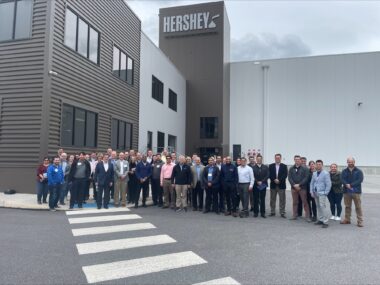
One thing that leadership emphasized on the tour was Hershey’s move from “best in cost” to “best in class.” Fulfilling Hershey’s vision as a snacking powerhouse means focusing on people-first manufacturing, which includes skill development, career advancement and teambuilding; innovating through technology, including through its digital factory strategy; and a focus on reliability. But in addition to its future aspirations, Hershey also needed to respond to evolving market and operational conditions – the company saw more volume growth during the pandemic, but retirements meant that its mean labor tenure decreased significantly, while lead times for packaging and capital equipment lengthened. Those shifts means that the company was left with a need to respond faster.
Investment in transformation capabilities has been essential. The company has moved away from conventional lines with single-purpose assets and focused SKU portfolios with complex line changeover requirements to advanced technology lines that can handle diverse SKUs with faster cleaning and changeover capabilities. Overall, Hershey’s digital factory strategy is focused on four areas: data capture and analysis to facilitate rapid problem identification and resolution; physical automation; a digital backbone (encompassing universal data architecture), and digital quality to bring forth a paperless shop floor. The company performs mass customization at scale through robotics and digital integration.
During the visit to the West Hershey production plant, which originally opened in 1990, attendees got an inside look at some of the production lines in the world’s largest and most technologically advanced chocolate manufacturing plant (750,000 square feet). It takes 26,000 cows to supply the milk needed to produce the Hershey’s Kisses (70 million a day), chocolate bars and syrup made here – one million pounds each of milk chocolate and Hershey’s Syrup each day. There is no storage for intermediaries at this facility – as soon as products are made, they are put onto a truck.
The 800,000-square feet Annville Fulfillment Center started production in October 2021, going from its groundbreaking to operation in just 16 months. It includes 62 trucking bays and 18 packing cells with flexibility to handle packages anywhere between two ounces and six pounds. Some of its advanced features include a cloud-based technology stack, digital work instructions for operators, and environmentally friendly battery-powered forklifts. The company will continue to scale up operations there as they leverage the facility’s full capacity.
The Annville facility is a joint operation between Hershey and its logistics partner, DHL. While Hershey owns the facility and its capital equipment, the majority of the workforce there are DHL employees. The Annville leadership team says that the partnership capitalizes on the strengths of both organizations, such as Hershey’s digital production know-how and DHL’s warehousing and logistics expertise. The facility utilizes a flex labor setup with cross-training between machine operators, palletizing operators and other functions to ensure that operations are adequately staffed at all times.
During the tour’s panel discussion at the end of the day, leadership emphasized that one important aspect of Hershey’s success is the company culture, originated by founder Milton Hershey more than 100 years ago. Bringing the workforce on board has allowed them to accelerate past “pilot purgatory” for the company’s digital aspirations. Panelists described what they call “Hershey nice” – a mix of collaboration and consensus-building where everyone treats each other with respect. The culture is vested in the company’s success, which therefore means that there is passion to share success and continually strive for improvements.
For that reason and many more, the company behind “the sweetest place on earth” might also be one of the sweetest places to work, and why Hershey is positioned to grow successfully toward its future aspirations – starting on the factory floor and branching out to snack lovers everywhere.
Witnessing World Class Manufacturing at Whirlpool Corporation
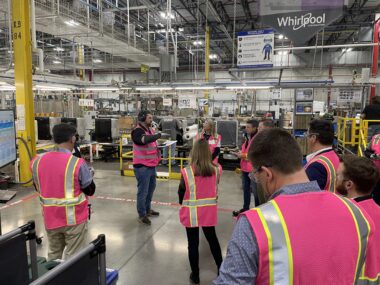
When Whirlpool Corp.’s Findlay Operations began its World Class Manufacturing (WCM) journey in 2018, the effort was envisioned as a standardized way to drive out waste and loss while keeping their customers in mind.
In March, the Whirlpool team welcomed guests for the Manufacturing Leadership Council’s sold-out tour of the company’s Findlay, Ohio, factory, where visitors learned about the WCM methodology, witnessed the facility in action, and heard directly from company leaders. The visit included information about automation efforts, sustainability programs, training programs, data collection and use, maintenance procedures, and kaizen and other continuous improvement processes.
The nearly 2,200 employees at the Findlay facility manufacture thousands of dishwashers each day including stainless steel and plastic tub varieties. The factory first opened in 1967 and has seen several additions, growing its footprint to one million square feet today. It is one of five Whirlpool manufacturing centers in Ohio and among 56 manufacturing and technology centers worldwide. In 2022, Whirlpool recorded $19.7 billion in net sales.
About World Class Manufacturing: Whirlpool Corp.’s Findlay Operations transitioned from a system based on the Toyota Production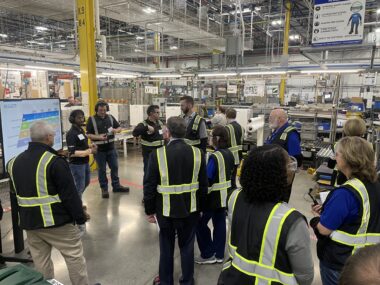 System to WCM in 2018. WCM features 10 Technical Pillars that are built on top of 10 Managerial Pillars. Both are essential to achieve WCM status. WCM’s primary goal is to increase quality while reducing production costs. The operating model focuses on driving out waste and loss by demonstrating successful pilot processes that are then spread broadly via standardization.
System to WCM in 2018. WCM features 10 Technical Pillars that are built on top of 10 Managerial Pillars. Both are essential to achieve WCM status. WCM’s primary goal is to increase quality while reducing production costs. The operating model focuses on driving out waste and loss by demonstrating successful pilot processes that are then spread broadly via standardization.
The WCM audit system has revealed significant progress at Whirlpool, Findlay Operations. Two times per year, the plant is audited by external parties to assess their progress against the WCM methodology. As pillars progress and meet specific criteria, they are awarded points. In the fall of 2022, the Findlay plant scored 53 points during their WCM audit. A score of 50 or more results in being awarded the Bronze-level award for WCM. The next milestone is at 60 points which is a Silver-level award. This scoring is standard for those using the WCM methodology.
What They Saw: For the nearly 100 MLC attendees, the highlight was seeing Whirlpool Corp.’s operation in action.
To make their way around the bustling factory, attendees were broken into seven tour groups, each named after a Whirlpool brand: Maytag, KitchenAid, Amana, JennAir, Swash, Gladiator, and the flagship brand Whirlpool.
During the seven-stop journey, tour leaders shared concrete examples of how standard work is put into practice and how continuous improvement, Kaizen activities and the Plan-Do-Check-Act (PDCA) cycle affect processes and help the company balance safety, quality, and costs. In fact, at the Workplace Organization stop, participants learned how the plant’s Kaizens have saved the plant millions of dollars since 2019.
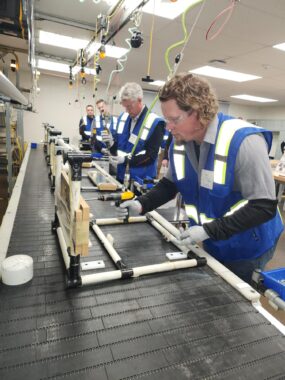 Along the route, participants saw Automated Guided Vehicles (AGVs) deliver supplies to workstations and heard from tour leaders and frontline leaders. At one stop, guests learned how flipping the dish rack when installing rack clips had saved time, avoided awkward hand and head angles, and decreased worker frustration. Elsewhere, a new lever – 3D printed on site – allowed workers to reduce the force necessary to install the dishwashers’ sump pumps, resulting in a five-year period without a reportable incident and two years without any first aid incidents.
Along the route, participants saw Automated Guided Vehicles (AGVs) deliver supplies to workstations and heard from tour leaders and frontline leaders. At one stop, guests learned how flipping the dish rack when installing rack clips had saved time, avoided awkward hand and head angles, and decreased worker frustration. Elsewhere, a new lever – 3D printed on site – allowed workers to reduce the force necessary to install the dishwashers’ sump pumps, resulting in a five-year period without a reportable incident and two years without any first aid incidents.
At yet another tour stop visitors saw an automated cell completing a foam-in-place process featuring a robot that has run millions of cycles to date. The company uses automation like this to avoid the 3Ds: tasks that are dull, dirty, or dangerous. Automation allows the company to avoid these 3Ds while providing safer and more interesting work to take place.
Off the factory floor, tour stops included a visit to the Compass Room where data on every machine and process is analyzed so the company can ensure safety and quality while reducing waste. The room provides a place for company leaders to look at the full picture, tie waste back to its root cause, and figure out priorities to address the top losses. From there, the groups also stopped for an overview of the company’s sustainability efforts, which include a pledge to achieve net zero by 2030 with the help of two on-premises wind turbines.
Finally, tour groups visited the Manufacturing Training Area (MTA) where the company demonstrated the training process that employees go through to learn new skills or brush up on existing capabilities. Every new hire starts their Whirlpool experience in Findlay’s MTA. In this training area, staff assess employees and then assign them to stations on the factory floor where they can operate safely and efficiently while measuring up to Whirlpool’s quality standard. To avoid monotony and repetitive stress injuries, Whirlpool workers each have at least three jobs they can do in the factory. Each worker rotates his or her position on the line to undertake these approved job functions during each shift. In fact, some workers are certified in as many as nine frontline jobs.
Diving Deeper During Breakouts and An Expert Panel: The plant tour concluded with three breakout sessions followed by an open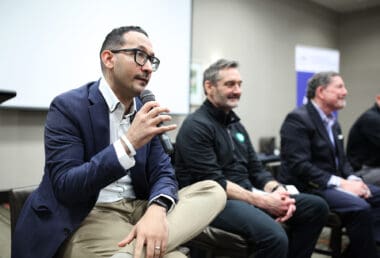 question and answer session with Whirlpool leaders. The breakouts allowed participants to learn more and ask questions about WCM, the Kaizen Management System, or MTA and People Development.
question and answer session with Whirlpool leaders. The breakouts allowed participants to learn more and ask questions about WCM, the Kaizen Management System, or MTA and People Development.
The tour contingent reconvened for an expert panel moderated by David R. Brousell, MLC’s co-founder and executive director. During a lively session, participants were able to pick the brains of some of Whirlpool’s brightest minds including Kristin Day, Findlay Operations Plant Leader; Ramsey Aljahmi, Operations Excellence Lead, NAR; Scot Blommel, Senior Manager, Global Sustainability; and Brent Schnipke, Ottawa Operations Plant Leader.
Award-Winning Leaders: There is no shortage of industry expertise and award-winning talent at Whirlpool’s Findlay plant. Kristin Day was recognized as a 2020 STEP Ahead Honoree by the Manufacturing Institute (MI), the nonprofit workforce development and education partner of the National Association of Manufacturers, MLC’s parent. Additionally, Industrial Engineering Manager, Tyra Woodruff, was honored with a STEP Ahead award in 2022, while Amy Doroff, Senior Manager, Material Control and Logistics, was honored as an MI Emerging Leader that same year. Now called the Women MAKE America Awards, the program recognizes women who have achieved success within their companies and proven to be leaders throughout the entire industry. MI’s Emerging Leaders are young women who have demonstrated exceptional accomplishments as they begin their careers.
MLC’s next plant tour will be at The Hershey Company on May 1-2. For more information about upcoming MLC plant tours: https://www.manufacturingleadershipcouncil.com/event/plant-tours/
